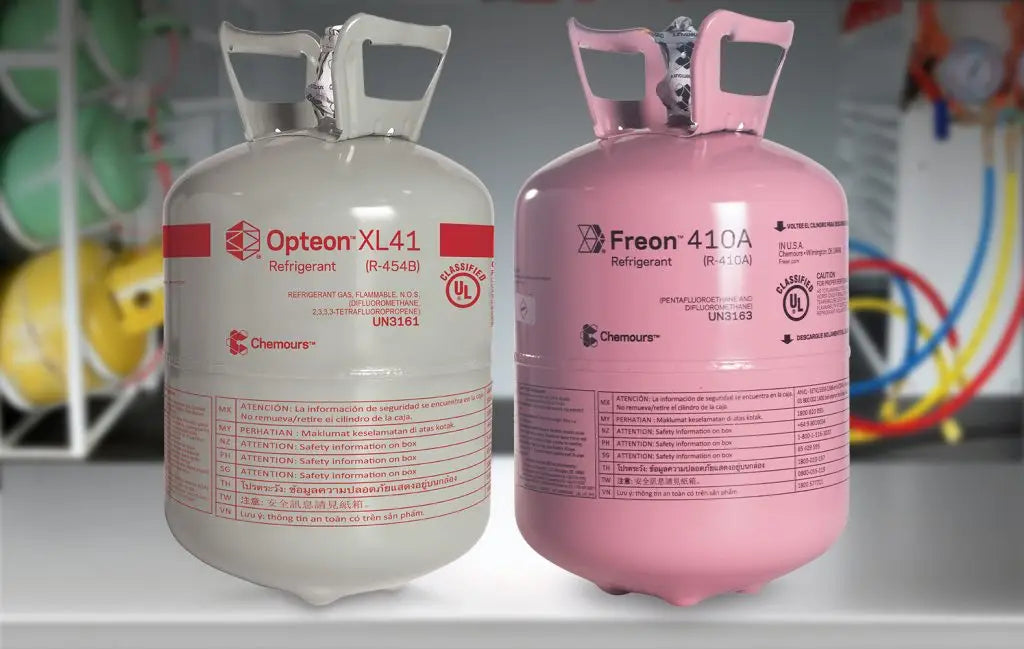When shopping for a new air conditioning system, one of the most important (yet often overlooked) decisions involves the type of refrigerant used. In 2025, the shift toward low-global-warming-potential (GWP) refrigerants is accelerating, and R-32 has emerged as a leading contender for environmentally conscious and cost-savvy homeowners.
This guide explains why R-32 is the smarter choice for your next central AC system and how it compares to other commonly used refrigerants like R-410A and R-454B.
❄️ What Is R-32?
R-32 (Difluoromethane) is a next-generation hydrofluorocarbon (HFC) refrigerant classified as an A2L refrigerant, meaning it is:
-
Low in toxicity
-
Mildly flammable (requires proper handling)
It is a single-component refrigerant, making it easier to recover, recycle, and service compared to refrigerant blends like R-410A or R-454B.
📘 Read Daikin’s global analysis on R-32 and its environmental benefits.
🌎 Environmental Impact: R-32 vs R-410A vs R-454B
| Refrigerant | Global Warming Potential (GWP) | Composition | Flammability Class |
|---|---|---|---|
| R-32 | 675 | Single substance | A2L (mildly flammable) |
| R-410A | 2,088 | Blend (R-32 + R-125) | A1 (non-flammable) |
| R-454B | 466 | Blend (R-32 + HFO-1234yf) | A2L |
🏆 Winner: R-32, for its balance of low GWP and single-substance composition.
⚙️ Performance Efficiency
-
Higher heat transfer efficiency than R-410A and R-454B
-
Requires less refrigerant charge per unit
-
Allows for smaller coil sizes and improved energy performance
📘 U.S. Department of Energy on refrigerant performance and transition
🔧 Ease of Service and Maintenance
Because R-32 is a single-component refrigerant:
-
Leaks are easier to detect and fix
-
No need to recharge with precision blending
-
More recyclable and reusable
By contrast, blended refrigerants like R-454B require stricter leak protocols and handling.
🏆 Winner: R-32, especially for HVAC contractors and DIY homeowners.
📉 Cost Savings Over Time
-
Systems using R-32 are often cheaper to maintain
-
Lower refrigerant costs compared to newer blends
-
Compatible with common service tools (with A2L-certified gauges and fittings)
Over a system’s 10–15 year lifespan, R-32’s simplicity translates to lower ownership costs.
🔒 Safety and Code Compliance
-
R-32 is A2L rated, meaning installers must follow safety protocols like ventilation, detection, and proper training
-
Most major HVAC brands now design systems specifically for A2L compliance
-
Building codes in 2024–2025 have evolved to accommodate R-32 installations
📘 See EPA guidance on refrigerant safety classifications
✅ Is R-32 the Right Choice for You?
R-32 is a great fit for:
-
Homeowners who want lower energy bills
-
Those seeking environmental responsibility
-
Anyone looking for long-term serviceability
-
Buyers of mid-range AC systems like the Goodman 3 Ton R-32 Bundle
While R-454B is also gaining ground, it’s more complex to service and often found in premium-priced systems.
🧮 Summary Table: Why R-32 Leads in 2025
| Factor | R-32 | R-410A | R-454B |
|---|---|---|---|
| GWP | 675 | 2,088 | 466 |
| Single Component? | ✅ Yes | ❌ No | ❌ No |
| Performance Efficiency | ⭐⭐⭐⭐ | ⭐⭐ | ⭐⭐⭐ |
| Ease of Service | ⭐⭐⭐⭐ | ⭐⭐⭐ | ⭐⭐ |
| Cost of Ownership | Low | Medium | High |
🌟 Final Takeaway: Choose Smart, Choose R-32
As the HVAC industry evolves toward sustainability and smarter technologies, R-32 strikes the perfect balance of performance, affordability, and environmental responsibility. Systems like the Goodman GLXS4BA3610 + AMST36CU1300 are designed with R-32 to deliver long-term value without sacrificing comfort.
Explore the Goodman 3 Ton R-32 Bundle or verify refrigerant certifications through the AHRI Directory.







